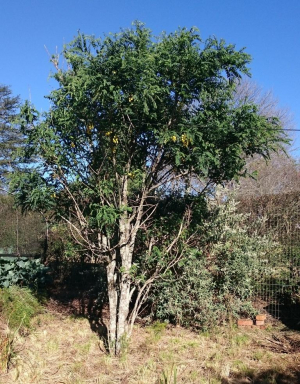Calpurnia aurea subsp. aurea (Common Calpurnia, Calpurnia, Wild Laburnum, Natal Laburnum)

Observation - Calpurnia aurea subsp. aurea (Common Calpurnia, Calpurnia, Wild Laburnum, Natal Laburnum) - Southern Africa. Description: A multi-stemmed shrub or a small graceful slender evergreen tree 2 - 4 m tall with a light, open crown. The leaves are compound, up to 20cm long, each having 5-15 pairs of leaflets and a terminal one. The leaflets are oblong 2.5-5cm long with a lopsided b
A multi-stemmed shrub or a small graceful slender evergreen tree 2 - 4 m tall with a light, open crown. The leaves are compound, up to 20cm long, each having 5-15 pairs of leaflets and a terminal one. The leaflets are oblong 2.5-5cm long with a lopsided base and a rounded or notched apex. They are a fresh light green, graceful and drooping.
From http://www.plantzafrica.com/plantcd/calpurnaur.htm:
The flowers are bright yellow, each about 2.5 cm long, in showy hanging bunches of 8 to 30 flowers. They appear irregularly throughout the year. In summer-rainfall areas the peak flowering period is mid-late summer (Dec-Feb), but in the winter-rainfall Western Cape, particularly during hot dry summers like the one we've just had, they don't flower well in summer but start up again in the autumn. They are typical pea flowers with the banner/standard, keel and wing petals characteristic of the family.
The fruit is a thin pod drying light brown with a papery texture, 5-12 cm long and 0.8-1.9 cm wide, narrowly winged on one side containing up to 8 brownish seeds. The pods are indehiscent (do not split open when mature).
Flowers are visited by carpenter bees and many other insects. In South Africa, calpurnia leaves and powdered roots are used to destroy lice and to relieve itches. The leaves are used to treat allergic rashes, particularly those caused by caterpillars. In East Africa, leaf sap is used to destroy maggots in wounds. In Nigeria, the seeds are used to treat abscesses. In Ethiopia it is used to treat stomach complaints, headache, eye diseases, amoebic dysentery, scabies and as an insecticide.